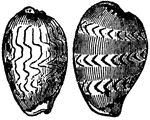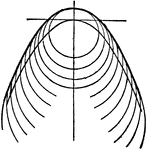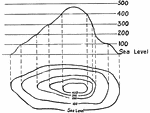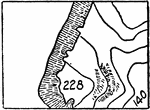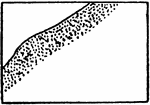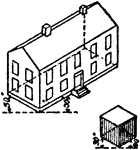
Construction Using Isometric Perspective
An illustration showing how to use isometric perspective. "This kind of perspective admits of scale…

Construction Of An Ellipse Tangent To Two Parallel Lines
An illustration showing how to construct an ellipse parallel to two parallel lines A and B. "Draw a…
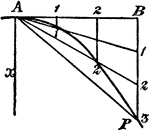
Construction Of A Parabola
An illustration showing how to construct a parabola. "Given the vertex A, axis x, and a point P. Draw…

Model Of Geometric Relationships In 2 Circles
An illustration showing a model of 2 circles with tangent lines, diameters, and radii that illustrates…

Model Of Geometric Relationships In 2 Circles
An illustration showing a model of 2 circles with tangent lines, diameters, and radii that illustrates…
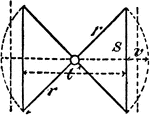
Intersecting Lines Of A Double Cone
An illustration showing a model of intersecting lines that that are formed by a double cone.
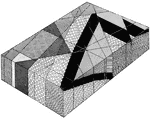
Basalt Diagram
"Diagram to illustrate the inferred structure in the vicinity of the "Triangle." Arkose conglomerate…

Position of the Bone, Cartilage, and Synovial Membranes
A diagram of the relative position of the bone, cartilage, and synovial membrane. Labels: 1,The extremities…
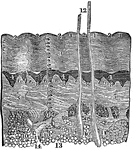
A Diagram of the Skin
A diagram of the skin. Labels: 1, The lines or ridges of the cuticle, cut perpendicularly. 2, The furrow…

Leaflet Removal
"Effect of removal of a leaflet from a palmately compound leaf (e.g. Woodbine). B, normal leaf; C, after…

Action of Semilunar Valve
Section of the aorta, to show the action of the semilunar valve. A is intended to show the valves, represented…
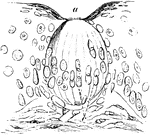
Taste Goblet from Dog's Epiglottis
Taste goblet from dog's epiglottis (laryngeal surface near the base) , precisely similar in structure…

Magnified Surface of a Hair
The hair is produced by a peculiar growth and modification of the epidermis. Externally it is covered…

Pons
Diagram of a longitudinal section through the pons, showing the relation of the nuclei for the ocular…
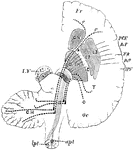
Cerebral Hemisphere
Diagram of the motor tract as shown in a diagrammatic horizontal section through the cerebral hemispheres…

Brain Showing Connection of Frontal Occipital Lobe with Cerebellum
Diagram to show the connecting of the Frontal Occipital Lobes with the Cerebellum. The dotted lines…
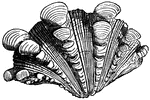
Tridacna Squamosa (Outside) (Lamarck)
"The center is a bright violet, with brownish longitudinal, punctured lines. All these are inhabitants…

Principle Fissures of the Brain
Showing the lines which indicate the position of the principal fissures of the brain.

Tridacna Squamosa (Inside) (Lamarck)
"The center is a bright violet, with brownish longitudinal, punctured lines. All these are inhabitants…

Winter Spores (teleutospores) on Wheat
These are very destructive parasites that attack valuable crops. Black lines and dots appear on the…

Summer Spores (Uredospores) on Wheat
These are very destructive parasites that attack valuable crops. Rusty lines and dots appear on the…
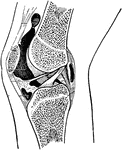
Epiphyseal lines in the Knee Joint
Epiphyseal lines in the neighborhood of the knee joint and their relationship to the synovial membrane.

Positioning
"Observe: That when drawn above the level of the eye, the bottom faces can be seen. (Boxes H, C and…
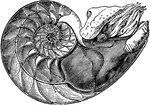
Nautilus Pompilius (Linnaeus), showing the interior of the lower cell, to which the animal is fixed.
"In the last partition of the shell is the animal, covered by its mantle, which lines to walls of the…

Tabanus Autumnalis
"The Tabanus Autumnalis is a common species, eight or nine lines in length, or a blackish color."
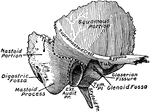
Temporal Bone
The outer surface of the temporal bone. The dotted lines indicate the lines of suture between squamous,…
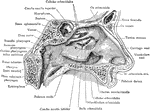
Nasal Cavity
The lateral wall of the left nasal cavity. The greater part of the middle turbinated bone has been excised…
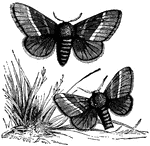
The Lackey (Bombyx Neustria)
"The Lackey derives its name from the color of the caterpillar, which has longitudinal lines of various…

Larva of the Odynerus Wasp
"There are solitary wasps which make their cells in holes, which they scoop out in the ground or in…

Frontal Section Through Knee Joint
Frontal section through knee joint, showing articulating surfaces and epiphyseal lines.
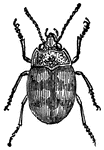
Omophron Libatum
"They are small almost globular, of a pale yellow with green lines, an live in sand bordering rivers."

Nebria Arenaria
"They are small almost globular, of a pale yellow with green lines, an live in sand bordering rivers.…
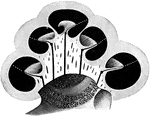
Osseous Labyrinth in Vertical Section
The osseous labyrinth in vertical section. The broken, white lines indicate the position of the basilar…

Vertical Section of a Tooth
Vertical section of a tooth in situ. Labels: c, pulp cavity; 1, enamel with radial and concentric markings;…

Degenerate Conic Forming Triangle
Illustration showing intersecting straight lines meeting to form a triangle. It is formed by the intersection…
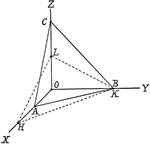
Plane
Illustration showing a how in "analytic geometry it is customary to specify the position of a plane…
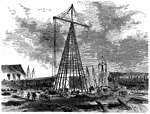
Derrick
An illustration of an iron derrick, a lifting device composed of one mast or pole which is hinged freely…
Spinal Nerves
Diagrammatic representation of the roots and ganglia of the spinal nerves, showing their position in…
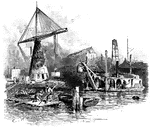
Dredging Boat and Derrick
An illustration of a dredging boat (right) and a derrick (left). A derrick is a lifting device composed…

Contour Lines
Contour lines never cross on the ground but in rare cases as an overhanging cliff they may cross on…

Contour Lines
A contour about to cross a stream runs up one side and down the other, making a V where it crosses,…

Vanishing Point
A vanishing point is a point in a perspective drawing to which parallel lines appear to converge.

Vanishing Point
A vanishing point is a point in a perspective drawing to which parallel lines appear to converge.

Vanishing Point
A vanishing point is a point in a perspective drawing to which parallel lines appear to converge.
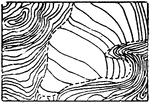
Glacier Contours
In cartography, a contour line (often just called a "contour") joins points of equal elevation (height)…

Glacier Form Lines
In cartography, a contour line (often just called a "contour") joins points of equal elevation (height)…
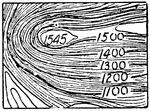
Contour System
In cartography, a contour line (often just called a "contour") joins points of equal elevation (height)…

Depression Contours
The typical representation of depression contours, if otherwise ambiguous, on a topographical map.
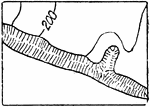
Bluffs, Other than Rocky
The typical representation of bluffs (other than rocky) on a topographical map.
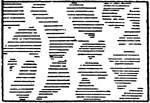
Tidal Flats of any Kind
The typical representation of shore lines and low-water lines with tidal flats of any kind on a topographical…

Street Car
An illustration of a horse-drawn street car. The first passenger services in the world were started…

Rocky Ledges
The typical representation of shores and low-water lines with rocky ledges on a topographical map.
